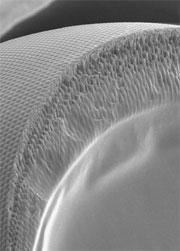 A cross-section of the artificial eye shows some of the tiny waveguides reaching into the centre from lenses on the outside.© Science
A cross-section of the artificial eye shows some of the tiny waveguides reaching into the centre from lenses on the outside.© ScienceCameras and robots might enjoy the all-round view that insects get with their multifaceted eye, thanks to a tiny artificial compound eye devised by Luke Lee and colleagues at the University of California in Berkeley.
Their false eye consists of a plastic hemisphere about 2.5 millimetres across, covered with more than 8,000 separate, tiny lenses; it can't yet truly 'see', because the lenses and the light they focus aren't yet hooked up to detectors.
But the researchers think that their artificial eye will be useful for future applications, including high-tech endoscopes that would give a doctor a much broader view inside a patient. They could even be used in tiny robots that could explore remote or dangerous environments in swarms. "The more they can see, the better," says Jaeyoun Kim, one of the Berkeley team.
Artificial versions of compound insect eyes have been made before, usually out of tiny lenses placed over pinholes with sensors beneath. But these have generally been flat. That makes them compact and easier to build, but they don't give a wide, panoramic view.
Bug-eyed
To mimic the round eye of a bug, an artificial eye needs to have little lenses hooked up to 'waveguides' — channels that funnel the incoming light from the outer edge of a sphere into the centre, where they can be hooked up to a detector.
These long, narrow channels ensure that each lens of the eye sees just the light that enters directly from above it, just as someone at the bottom of a deep well can only see the sky directly overhead. This tunnel vision is the key to a good compound eye, because it means that the images from adjacent channels don't overlap and confuse the picture.
But assembling thousands of miniature lenses and channels one by one would be incredibly fiddly. Instead, Lee's team found a way for each little lens to effectively 'burn out' its own light-carrying channel in the material beneath. They report their efforts in Science1.
The team's first step was to make a honeycomb array of lenses on a dome-shaped rubbery shell. Lee and colleagues then filled this shell with a hemisphere of a transparent, light-sensitive resin; the chemical structure of this resin is altered when it is exposed to intense ultraviolet light.
All burnt out
Each lens in the dome-shaped array, just 25 thousandths of a millimetre across, focuses incoming light on to a point beneath it, 'burning' a little bit of the resin and changing its refractive index. Light then gets trapped in this part of the material, as it would within a fibre-optic cable. More incoming light burns further down into the hemisphere, lengthening the tiny waveguide.
Currently, the waveguides don't quite make it all the way to the centre of the dome, because the resin absorbs some of the light and eventually the intensity gets too low to 'burn' the material. A less absorbent resin would allow the waveguides to penetrate deeper, the team says.
ADVERTISEMENT
So there are a few challenges to face before the Berkeley team's eye becomes functional. But once the waveguides are made a little longer, and the result hooked up to detectors, the artificial eye will see a broad view of the world, knitted together from the thousands of little pictures generated by each lens.
Visit our eyebuilttospy_al.html">newsblog to read and post comments about this story.
-
References
- Jeong K.-H., et al. Science, 312. 557 - 561 (2006). | Article |
